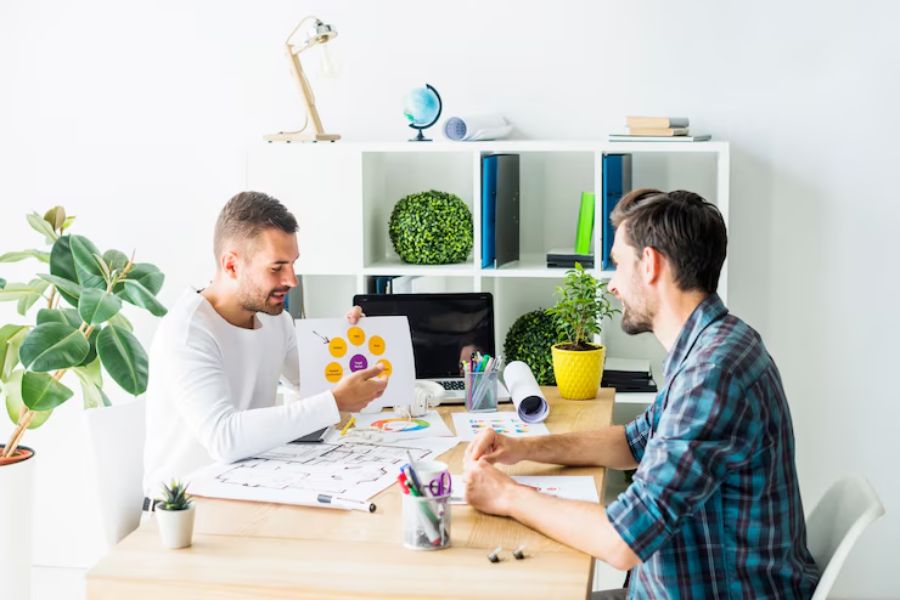Productivity by Design: How Colors, Layouts, and Tools Influence Your Efficiency

In a world where distractions are just a click away and remote work is more prevalent than ever, the way we design our spaces plays a critical role in how efficiently we work. From the colors on the walls to the way our tools are arranged, design has a tangible impact on our productivity. This article explores how color psychology, room layouts, and smart tools can work together to boost efficiency and transform your space into a powerhouse of focus and creativity.
The Psychology of Color in Workspaces
Color isn’t just a decorative choice it affects our mood, energy, and cognitive function. According to multiple studies in environmental psychology, certain hues can either enhance or hinder our productivity depending on how they are used.
- Blue is often associated with calm, focus, and logic. It’s ideal for detail-oriented tasks.
- Red stimulates energy and urgency, great for tasks that require physical activity or alertness.
- Yellow sparks creativity and optimism perfect for creative professionals.
- Green, on the other hand, creates a sense of balance and calm, reducing anxiety and promoting mental clarity.
For anyone looking to incorporate a calming yet energizing touch to their workspace, using green wallpaper for walls can be an excellent way to introduce nature-inspired tranquility that promotes steady focus throughout the day.
Layouts That Work: Creating Flow and Function
Just like a well-written story, your workspace should have a logical flow. The layout can either support your natural workflow or disrupt it. Here are a few principles of productivity-enhancing layouts:
1. Zoning
Divide your space into zones based on activity: a zone for focused work, another for brainstorming or creative processes, and perhaps a third for meetings or casual interactions. This helps you mentally transition between different types of tasks without physically leaving the room.
2. Proximity to Tools
The most frequently used tools should be within arm’s reach. If you constantly have to get up to fetch items like notebooks, charging cables, or reference books, you’re likely breaking your flow without realizing it.
3. Minimalism and Decluttering
A cluttered desk is a cluttered mind. Keeping your space clean and minimal reduces cognitive load and helps you concentrate. Use organizers, hidden storage, or digital tools to reduce physical mess.
4. Natural Light and Positioning
Position your desk near a window if possible. Natural light improves mood and alertness, while the occasional glance at nature can serve as a mini mental reset without leading to full-blown distraction.
Digital Tools: Design Your Workflow as Well as Your Space
Productivity isn’t just about your physical environment. The digital tools you use, their appearance, functionality, and level of integration also impact your workflow. Here’s how digital design choices matter:
1. Intuitive Interfaces
A clean, user-friendly design in productivity apps helps reduce friction. The less time you spend figuring out how to use a tool, the more time you spend actually getting things done. Look for apps with streamlined dashboards, customizable templates, and easy navigation.
2. Automation and Integrations
Tools like task managers, calendars, and note-taking apps are more powerful when they can talk to each other. Integrating platforms like Notion, Google Workspace, or Trello with Slack or Zapier can automate repetitive tasks and prevent duplication of effort.
3. Visual Cues
Use digital color coding, icon systems, or kanban boards to organize your tasks visually. Just like physical color and layout, visual systems in software support mental categorization and prioritization.
Designing for Different Work Styles
Everyone has different work rhythms, and designing your space to fit your style is crucial. For example:
- The Visual Thinker benefits from whiteboards, wall planners, and open shelving that makes tools and tasks visible.
- The Minimalist prefers clean lines, neutral tones, and hidden storage to stay mentally clear.
- The Creative Professional may thrive in more eclectic spaces with bursts of color, inspirational art, and flexible furniture.
Matching your physical and digital environments to your personal productivity style helps you work with your instincts instead of against them.
Biophilic Design: Nature’s Role in Productivity
There’s growing interest in biophilic design bringing nature into the workspace. This can include:
- Adding plants for visual relief and better air quality.
- Using natural materials like wood, cork, or stone.
- Incorporating colors inspired by nature like leafy greens, sky blues, and earthy browns.
Even something as simple as hanging artwork with forest imagery or using wall murals can simulate the soothing effects of nature and create a more relaxed, focused environment.
Ergonomics and Furniture Arrangement
Bad posture, uncomfortable chairs, or improperly placed screens can lead to fatigue, discomfort, and lower productivity. A productive space should:
- Use a desk and chair combination that supports your posture.
- Keep screens at eye level to avoid neck strain.
- Place input devices (keyboard, mouse, tablet) in a natural reach zone.
- Include standing desk options or flexible seating to prevent stagnation.
Aesthetically pleasing doesn’t mean impractical, your space should be as functional as it is beautiful.
Lighting: Setting the Right Tone
Lighting has a major impact on alertness and energy levels. Harsh overhead fluorescents can cause eye strain and headaches, while too-dim lighting leads to drowsiness.
Use a mix of ambient, task, and accent lighting to create a balanced atmosphere. Smart lighting systems that mimic natural light patterns can also help regulate your circadian rhythm, keeping your energy more consistent throughout the day.
Final Thoughts: Design With Purpose
Your environment is never neutral, it either supports your goals or stands in the way. Thoughtful design whether it’s choosing the right shade of green, organizing your digital workspace, or investing in ergonomic furniture can create the conditions for deep work and creative breakthroughs.
Design isn’t just about aesthetics; it’s about function, flow, and feeling. When you take control of your surroundings, you’re not just decorating, you’re designing for success.
